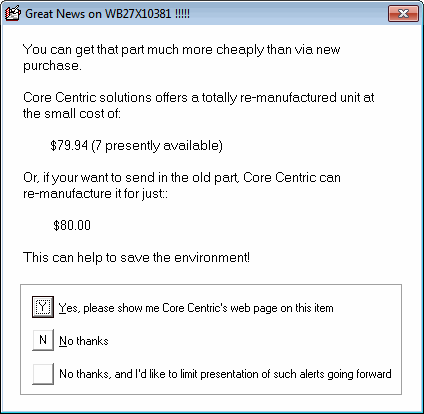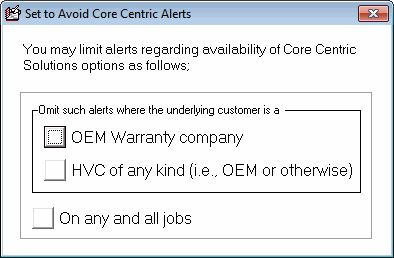ServiceDesk 4.8.137 Update 12/26/19
SD-QuickPics May Now be Used with Almost any File Type
Until now, the SD-QuickPic system would only permit you to use JPEG-type files (i.e., files ending with extension ".jpg").
Of course, that's a file type that involves pictures. Therefore, it's only been pictures you could use in the SD-QuickPics system.
Sure, that fits with the title of the system (specifically, "SD-QuickPics"). However, many people have wanted to use other kinds of files via this tool, including PDF documents, Excel spreadsheets, Word documents, etc.
So, now you can.
Specifically, the system will now permit you to drag-and-drop within ServiceDesk any file whose name ends with the following extension types:
.jpg, .png, .gif, .pdf, .txt, .rtf, .doc, .docx, .xls, .xlsx
These will then be accessible via all the standard means.
SD-QuickPics May Now be Created Via UnitInfo Records
From the beginning, any object in the SD-QuickPic system could be attached to: (a) a particular technician visit; (b) a particular JobRecord; and/or (c) a particular UnitInfo record (in many context the connection would be made to all three of these at once).
Initially, however, the locus for creating these QuickPic objects (along with any relevant attachments) resided solely in the various SD-QuickPics apps, which are of course intended for use by technicians in the Mobile environment.
There was, in other words, no mechanism to create these objects from within SD itself.
That was addressed some 30 months ago, as described here.
In particular, the above solution allowed you to create QuickPic objects from within SD (along with applicable attachments) by a simple drag-and-drop into the QuickPics icon as found within any (F7) JobRecord.
Recently a client asked for ability to do the same in regard to the QuickPics icon as present in a (Shift-F12) UnitInfo record.
This ability is now added.
SD-Created Outgoing SMS Text-Messages May Now Ignore the 160-Character Limit
While there are many methods by which to create and send SMS text-messages from within ServiceDesk (see here and here, as examples), all have been subject to a technical constraint: by the very nature of the underlying technology, no SMS packet may contain more than 160 characters.
Thus, until now, if from within ServiceDesk you tried to manually invoke a SMS send that exceeded this quantity, you'd get a message like this:
All of which might lead to a reaction from you such as: "What you say? . . . I send and receive bigger SMS messages all the time!"
Well, you're sort of right.
What actually happens is, if from a smartphone you "send" a larger than 160-character message, your device and carrier cooperate to split the message into multiple units of 160-characters or less (with each in fact transmitted individually), then the full message is pasted back together at the receiving end (at least this happens usually; in some contexts the pasting back together may not occur).
Therefore, though it generally looks like you're doing bigger-than-160-character messages, in fact, the underlying machinery still obeys the technical limit.
That's all as background to the fact that, because our own SMS-sending machinery did not have such magic incorporated, we had to obey the technical limit.
What's new is we've now added such magic. Therefore, you may now do longer messages if you wish.
PartsPick Interface Now Provides Better Heads-Up to Alert if Special-Order Parts Not Yet Arrived
The fact that this was needed was, candidly, kind of an embarrassing oversight.
The middle list within in this interface (Shift/Ctrl-F8) details special-order items that a tech should have with him so as to complete his roster or work as applicable to any day. The intent is you use the list to assure you're providing such items to the tech, for that day. Color coding is included to show differences such as: "He needs this item, but the system reckons it is already in his possession" (specifically, any such item will show in green, and on such basis you know that, though it's an item the tech needs to have with him on that date, you do not need to separately provide it to him).
The sad thing is, it turns out we'd not thought to put in any similarly-direct notice for where a part has been ordered for a job on the applicable roster, but has not yet been checked in as having been received. All we'd done for this situation, so far, is made it so, if a user claims he or she is moving such a part to the tech, a message comes up like this:
Well, now that deficiency is addressed.
In particular, items in the list which do not internally show as having been received will list-display in a yellow color, plus a note will appear above that explains what that yellow color means.
PartsProcess Interface May Now Filter for All-HVCs and No-HVCs
The Current-PartsProcess interface (F8) has long had a very robust set of filtering options. As one filtering category (and as an example), you've long been able to choose to work only on such items as pertain to a particular High-Volume-Client (HVC).
Now there are more options in this category, as seen here:
Automated Invitations to Use CoreCentric Solutions as Source for Part
A few releases back (see here) we added CoreCentric Solutions to the list of resources you may auto-link to when wanting to online inquire on any particular partnumber.
In principle, that's great. However, to benefit a user must actively trigger the inquiry. Obviously, you can't count on this always being done.
That's an issue because it's likely, at least usually, you want your part-ordering persons to know when a CoreCentric alternate is available. In many cases, this will earn your company the enhanced revenue that comes from completing a repair, versus only completing a service call. This is true for at least two reasons:
These days, parts are often no-longer-available (NLA) from standard sources, and, yet, these are often the same parts CoreCentric offers. If your repair needs such a part, the CoreCentric source can uniquely make it possible.
Likewise these days, electronic boards are often so expensive as to make the total repair cost impractical. Again, these are likewise often the same parts CoreCentric offers -- meaning, because of the CoreCentric offering (and assuming that you're aware of it), you're now enabled to bring the total cost into a range your customer will accept. There may in fact now be room for a larger labor amount in that total, which will further enhance your bottom line.
Besides adding to your revenue for the reasons described, the CoreCentric alternative will often leave your customer feeling happier because of a completed repair and at lower cost (thus enhancing your prospect for future work). There is likewise significant benefit to the environment because a whole appliance resists going to scrap and its replacement is not manufactured. The same is true for the part itself.
Given the above, it seems obvious you'll have a preference for your company to be taking advantage of CoreCentric alternates when they are available and when circumstances allow. This new feature enables you to significantly actualize that preference.
What it does, specifically, is self-invoke a behind-the-scenes (invisible to the user) inquiry on the applicable partnumber whenever you click into a (F8) PartsProcess record. This inquiry is made to CoreCentric's server, and essentially "asks" if the partnumber is one on which CoreCentric can provide a replacement or rebuild. If the answer comes back as a "yes," ServiceDesk presents a message similar to this (if the answer is not yes, the user will be totally unaware that any inquiry occurred):
If you opt to see CoreCentric's web page on the item, ServiceDesk of course opens that for you (if you have no interest, you can either pick "No thanks" or hit Esc).
Please note there is a third option whereby you may choose to limit such presentations going forward. We provide this because: (a) if you simply don't want these alerts, you should have a right to avoid them; and (b) it's possible particular classes of your customers disallow use of re manufactured parts, and, if so, it would make good sense for you to not be bothered by these alerts when involved with jobs working for such customers. Thus, if you choose that third option you'll see choices as follows:
Please note if you choose any of the above "Omit" options, your choice is deliberately engineered to have a limited life. The reason is because we reckon some folks might make this choice hastily, and on a future date might have a different sentiment. Thus, your choice to"Omit" will in fact last 100 days. If you feel the same when you're next presented with a "Great News . . ." message, just choose again and you'll be good for another 100 days.
P.S. If you did not know, the electronic boards that you purchase from standard sources (e.g., OEM parts distributors) are often not genuinely new, and are themselves re-manufactured (in many cases, in fact, by CoreCentric). The major difference is, if buying directly from CoreCentric, you'll be paying a fraction of the price.





